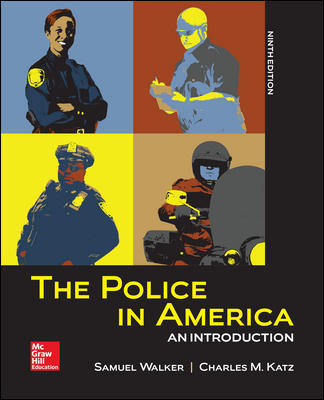Test Bank For The Police in America An Introduction 9Th Edition By By Samuel Walker
Digital item No Waiting Time Instant DownloadISBN-13: 978-1259140761 ISBN-10: 1259140768
In Stock
Original price was: $65.00.$24.00Current price is: $24.00.
Test Bank For The Police in America An Introduction 9Th Edition By By Samuel Walker
Chapter 03 The Contemporary Law Enforcement Industry
Multiple Choice Questions
1. Which of the following levels of government holds the primary responsibility for police protection?A. federalB. state and localC. cities and countiesD. municipalities and corporations
Accessibility: Keyboard Navigation
2. There is no formal, centralized system for coordinating or regulating all of the different law enforcement agencies. This decentralization is known asA. fragmentation.B. agglomerization.C. industrial perspective.D. dispersed employment.
Accessibility: Keyboard Navigation
3. The difference between a law enforcement agency’s approved allotment of officers and the number of officers currently employed is known asA. endorsed strength.B. authorized strength.C. personnel strength.D. sworn strength.
Accessibility: Keyboard Navigation
4. The process of replacing sworn officers with nonsworn personnel for certain positions is known asA. authorization.B. cost management.C. effective utilization.D. civilianization.
Accessibility: Keyboard Navigation
5. The standard measure for the level of police protection in a community, usually expressed as the number of sworn officers per thousand residents, is calledA. community-police ratio.B. police-population ratio.C. police-protection ratio.D. crime-police ratio.
Accessibility: Keyboard Navigation
6. The authors list two major remedies for issues associated with fragmentation. They areA. consolidation and contracting.B. increased protection and crime reduction.C. higher arrests and prosecutions.D. effectiveness and efficiency.
Accessibility: Keyboard Navigation
7. Which of the following is the reason why city police are the most important component of the law enforcement system in America?A. They receive the most money from allotted budgets.B. They are the most obvious component in any city.C. They represent a majority of all law enforcement agencies.D. They train for all potential situations in residential life.
Accessibility: Keyboard Navigation
8. Sheriffs have a unique role in that they serve all three components of the criminal justice systemA. executive, legislative, and judicial.B. protection, service, and commitment.C. management, efficiency, and quality.D. law enforcement, courts, and corrections.
Accessibility: Keyboard Navigation
9. The office of the coroner, or medical examiner, is often considered a law enforcement agency because it has the responsibility toA. investigate crimes.B. conduct autopsies.C. investigate the cause of death.D. assist police in murder investigations.
Accessibility: Keyboard Navigation
10. The agency having statewide police powers for traffic regulation and criminal investigation is known asA. highway patrol.B. state police.C. Department of Transportation.D. Department of Criminal Justice.
Test Bank for “The Police in America: An Introduction,” 9th Edition by Samuel Walker
Overview:
- Title: The Police in America: An Introduction
- Edition: 9th
- Authors: Samuel Walker, Charles M. Katz
- Focus: This textbook provides a comprehensive overview of policing in the United States, examining the role of the police, the challenges they face, and the impact of their work on society. The 9th edition updates the content to reflect recent developments and trends in policing.
Content Details:
- Introduction to Policing:
- Overview of the history and evolution of policing in America.
- The role of police in society and their relationship with the community.
- Analysis of the various functions and responsibilities of law enforcement agencies.
- The Structure and Organization of Police Agencies:
- Detailed examination of the organization and structure of police departments.
- Discussion on the different types of police agencies, including federal, state, and local levels.
- Exploration of the chain of command, roles, and responsibilities within a police department.
- Police Work:
- Insight into the day-to-day duties and activities of police officers.
- Coverage of patrol work, investigations, and specialized units.
- Examination of the use of discretion and decision-making in policing.
- Legal Aspects of Policing:
- Overview of the legal framework governing police work, including constitutional rights, laws, and regulations.
- Discussion on the issues of police accountability, use of force, and civil liberties.
- Analysis of court cases that have shaped policing practices.
- Policing Strategies and Tactics:
- Exploration of different policing strategies, including community policing, problem-oriented policing, and zero-tolerance policing.
- Discussion of the effectiveness and challenges of these strategies.
- Review of modern policing technologies and their impact on law enforcement.
- Challenges in Policing:
- Examination of the challenges facing police forces, such as crime prevention, terrorism, and maintaining public trust.
- Discussion on issues like police corruption, racial profiling, and the use of deadly force.
- Analysis of current trends and future directions in policing.
- The Relationship Between Police and Society:
- Analysis of the interactions between police and different segments of society.
- Discussion on police-community relations, trust, and the impact of media on policing.
- Exploration of strategies for improving police legitimacy and public perception.
Features:
- Updated Content: The 9th edition includes the latest data, case studies, and examples reflecting current issues in policing.
- Critical Thinking Exercises: Questions designed to encourage students to critically evaluate policing practices and their societal implications.
- Practice Tests: Comprehensive tests covering each chapter to reinforce key concepts and assess understanding.
- Case Studies: Real-life scenarios and case studies that illustrate the complexities of policing.
Conclusion:
The test bank for “The Police in America: An Introduction,” 9th Edition by Samuel Walker is an essential resource for students and educators in criminal justice. It provides a wide range of questions that assess knowledge of the structure, functions, and challenges of policing in the United States. This test bank helps to deepen students’ understanding of the complex role that police play in society, while also preparing them for examinations and practical applications in the field of law enforcement.


Reviews
There are no reviews yet.